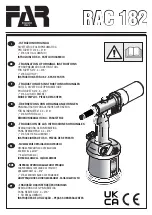
2
JCT-4660 series Paving Breaker
Safety warnings
General air tool warnings
1. Read and understand this entire manual
before attempting assembly or operation.
2.
Read and understand all warnings posted on
the tool and in this manual. Failure to comply
with all of these warnings may cause serious
injury.
3. Replace warning labels if they become
obscured or removed.
4.
Do not use this tool for other than its intended
use. If used for other purposes, JET disclaims
any real or implied warranty and holds itself
harmless from any injury that may result from
that use.
5. Always wear ANSI Z87.1 approved safety
glasses or face shield while using this tool.
(Everyday eyeglasses only have impact
resistant lenses; they are
not
safety glasses.)
6. Wear ear protectors (plugs or muffs) if the
noise exceeds safe levels.
7. Wear gloves and protective clothing if
operation produces sparks or flying particles.
Gloves should be tight-fitting, without frayed
fingers or hanging threads. Keep hands and
body away from the working area of tool.
8.
Some dust created by power sanding, sawing,
grinding, drilling and other construction
activities contains chemicals known to cause
cancer, birth defects or other reproductive
harm. Some examples of these chemicals
are:
• Lead from lead based paint.
• Crystalline silica from bricks, cement and
other masonry products.
• Arsenic and chromium from chemically
treated lumber.
Your risk of exposure varies, depending on
how often you do this type of work. To reduce
your exposure to these chemicals, work in a
well-ventilated area and work with approved
safety equipment, such as face or dust masks
that are specifically designed to filter out
microscopic particles.
9.
Do not operate an air tool continually at full
throttle without a work load on the tool.
10. The air tool must be properly lubricated before
operating.
11. Never start a percussion type air tool (chipper,
breaker, buster, etc.) without securing the
tooling in the retainer and placing the tip
against the work surface.
12. Do not operate air tool without its guards in
place. Do not modify the tool.
13. Do not operate this tool while tired or under
the influence of drugs, alcohol, or any
medication.
14. Adopt a comfortable posture with proper
balance, and maintain secure footing at all
times. Non-slip footwear or anti-skid floor
strips are recommended.
15. Do not wear loose clothing or jewelry. Confine
long hair.
16. Excessive air pressure and too much free
rotation may decrease life of the tool and may
cause a hazardous situation.
17. Check air hoses for wear, and keep them
away from heat and sharp edges. Repair or
replace damaged air hose immediately. Do
not carry tool by the air hose.
18. Air hose may cause tripping hazards; keep
hose away from traffic areas.
19. Do not use this tool near flammable objects,
or in potentially explosive environments. Do
not use near live electrical wires.



































